Grumman G-21 Goose
The Grumman G-21 Goose is an amphibious flying boat designed by Grumman to serve as an eight-seat "commuter" aircraft for businessmen in the Long Island area. The Goose was Grumman's first monoplane to fly, its first twin-engined aircraft, and its first aircraft to enter commercial airline service. During World War II, the Goose became an effective transport for the US military (including the United States Coast Guard), as well as serving with many other air forces. During hostilities, the Goose took on an increasing number of combat and training roles.
| G-21/JRF Goose | |
|---|---|
 | |
| Role | Transport amphibious aircraft |
| Manufacturer | Grumman |
| First flight | 29 May 1937 |
| Primary users | United States Navy United States Army Air Forces Royal Air Force Royal Canadian Air Force |
| Number built | 345 |
Design and development
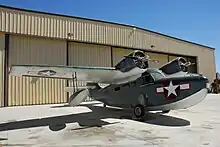
In 1936, a group of wealthy residents of Long Island, including E. Roland Harriman, approached Grumman and commissioned an aircraft that they could use to fly to New York City.[1] In response, the Grumman Model G-21 was designed as a light amphibious transport. Grumman produced a high-wing monoplane of almost all-metal construction—the trailing half of the main wing and all of the flight control surfaces except for the flaps were fabric-covered. It was powered by two 450 horsepower (340 kW) Pratt & Whitney R-985 Wasp Junior nine-cylinder, air-cooled, radial engines mounted on the leading edges of the wings. The deep fuselage served also as a hull and was equipped with hand-cranked retractable landing gear. First flight of the prototype took place on May 29, 1937.[2]
The fuselage also proved versatile, as it provided generous interior space that allowed fitting for either a transport or luxury airliner role. Having an amphibious configuration also allowed the G-21 to go just about anywhere, and plans were made to market it as an amphibian airliner.[3]
Modifications
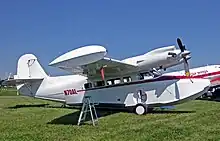
A number of modifications were made for the Goose, but the most numerous are those by McKinnon Enterprises of Sandy, Oregon, which holds 21 supplemental type certificates (STCs) for modifying G-21-series aircraft and which also manufactured four different conversions that were recertified under a separate FAA type certificate as brand-new "McKinnon" airplanes.[4] The first was the McKinnon model G-21C which involved replacing the original R-985 radial engines with four Lycoming GSO-480-B2D6 piston engines. It was approved under TC 4A24 on November 7, 1958, and two examples were converted in 1958–1959.
New production
In November 2007, Antilles Seaplanes of Gibsonville, North Carolina, announced it was restarting production of the turbine-powered McKinnon G-21G Turbo Goose variant, now identified as the Antilles G-21G Super Goose.[1] Pratt & Whitney Canada PT6A-34 turboprops flat-rated to 680 shp (510 kW) would have replaced the original PT6A-27 engines,[1] and the airframe systems and especially the avionics (aviation electronics – i.e. radios and navigation systems) would have been updated with state-of-the-art "glass panel" instrumentation and cockpit displays. However, as of 2009, Antilles Seaplanes' manufacturing center has been foreclosed and sold at auction. The fate of new Goose production is currently unknown.[5]
Operational history
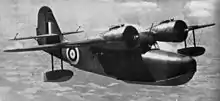
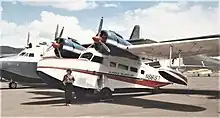
Envisioned as corporate or private flying yachts for Manhattan millionaires, initial production models normally carried two to three passengers and had a bar and small toilet installed. In addition to being marketed to small air carriers, the G-21 was also promoted as a military transport. In 1938, the U.S. Army Air Corps purchased the type as the OA-9 (later, in the war years, examples impressed from civilian ownership were designated the OA-13A). The most numerous of the military versions were the United States Navy variants, designated the JRF.
The amphibious aircraft was also adopted by the Coast Guard and, during World War II, served with the Royal Canadian Air Force in the transport, reconnaissance, rescue, and training roles. The G-21 was used for air-sea rescue duties by the Fleet Air Arm, who assigned the name Goose. A single aircraft was used briefly by No. 1 Air Ambulance Unit, Royal Australian Air Force in the Mediterranean.[21]
After the war, the Goose found continued commercial use in locations from Alaska to Catalina and the Caribbean.
A total of 345 were built, with about 30 known to still be airworthy today (although around 60 are still on various civil registries, many of them are known to have crashed or been otherwise destroyed), most being in private ownership, some of them operating in modified forms.[6]
Variants
- G-21
- The original production version, these were powered by two 450 hp (340 kW) Pratt & Whitney Wasp Junior SB engines, at 7,500 lb (3,400 kg) gross weight, with six passengers, and 12 were built, all converted to G-21A standards.[7]
- G-21A
- Increased gross weight (8,000 lb (3,600 kg)), 30 built.[7]
- G-21B
- Export coastal patrol flying boat armed with .30 in (7.62 mm) machine gun in bow and dorsal hatches and two 100 lb (45 kg) bombs underwing, 12 built for Portuguese Naval Aviation.[7]
- G-21C
- Conversion by McKinnon Enterprises, these were re-engined with four 340 hp (250 kW) Lycoming GSO-480-B2D6 air-cooled, geared, and supercharged flat-six engines and fitted with retractable wingtip floats, a fiberglass radar nose, a one-piece wraparound windshield, and enlarged cabin windows; gross weight increased to 12,499 lb (5,669 kg) as result of internal structural reinforcements. Two were converted as piston-powered models G-21C in 1958–1959, and two other airframes subsequently were converted in 1968, but with two 550 shp (410 kW) Pratt & Whitney Canada PT6A-20 turboprops per STC SA1320WE as G-21C Hybrids. Two G-21C Hybrids were identical to the later 10,500 lb (4,800 kg) model G-21E, but they were never certified as such.[8]
- G-21D
- One G-21C was further converted by McKinnon with an extended nose marked by two extra windows on each side and accommodating another four passengers. Recertified as G-21D in 1960. In 1966, it was re-engined with two 550 shp (410 kW) PT6A-20 turboprops and fitted with revised Alvarez-Calderon electric flaps in accordance with STC SA1320WE, retaining the G-21D designation, but subsequently identified as the McKinnon "Turboprop Goose".[9]
- G-21E
- A fully certified new model, it was based on a simplified turbine conversion of the McKinnon G-21C, with 550 shp (410 kW) PT6A-20 engines (680 shp (510 kW) Pratt & Whitney Canada PT6A-27 engines optional) and more fuel, but without all of the structural reinforcements of the G-21C. 10,500 lb (4,800 kg) gross weight. One converted.[4]
- G-21G
- The final McKinnon conversion also was fully certified as a new model with 680 shp (510 kW) PT6A-27 engines, 586 US gal (2,220 L; 488 imp gal) of fuel, and 12,500 lb (5,700 kg) gross weight. Two converted.[10]
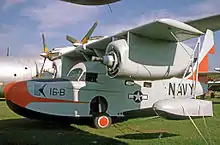
- Kaman K-16B
- Experimental tilt wing aircraft, with JRF-5 fuselage powered by two General Electric YT58-GE-2A engines; one built but not flown.[11][12]
- XJ3F-1
- Prototype eight-seat utility amphibian, built for the US Navy; one built in 1938.[7][13]
- JRF-1
- Production XJ3F-1, five built for US Navy.[7]
- JRF-1A
- Similar to JRF-1, but with target towing gear and camera hatch added, five built for US Navy.[7]
- JRF-2
- U.S. Coast Guard version with provisions for carrying stretchers; seven built.[7]
- JRF-3
- Similar to the JRF-2, fitted with autopilot and deicing boots on the wing leading edges for Arctic operations. Three built for US Coast Guard.[7][14]
- JRF-4
- Similar to JRF-1A, these could carry two underwing depth bombs. Ten built for US Navy.[7]
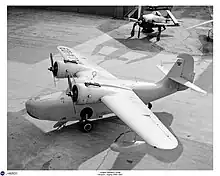
- JRF-5
- Major production version with bomb racks, target towing and camera gear, and deicing gear; 184 built.[7] In 1953, a modified JRF-5 tested hydroskis for the US Navy.[15]
- JRF-5G
- 24 JRF-5s transferred to the US Coast Guard.[7][14]
- JRF-6B
- Navigation trainer purchased for supply under Lend-Lease; 50 built.[7]
- OA-9
- Transport and air-sea rescue for United States Army Air Forces, 26 ordered in 1938, supplemented by five JRF-6Bs under the same designation.[7][14]
- OA-13A
- Three G-21As impressed by the USAAF.[7][16]
- OA-13B
- Two JRF-5s transferred to the USAAF.[7][16]
- Goose Mk.I
- British designation for three JRF-5s supplied to the Fleet Air Arm.[17]
- Goose Mk.IA
- British designation for 44 JRF-6Bs, supplied under Lend Lease for observer training by the 749 Naval Air Squadron in Trinidad.[17]
- Goose Mk.II
- British designation for two JRF-5s staff transports for British Air Commission in the United States and Canada.[17]
Operators
Military operators

- Argentine Naval Aviation
- Six aircraft were used 1947–1966.[18]
- Royal Australian Air Force
- A single aircraft was used briefly by No. 1 Air Ambulance Unit RAAF in the Mediterranean.[19]
- Bolivian Air Force
- At least two aircraft (one JRF-2 and one JRF-6B) received in 1942.[20]
- 10 used for anti-submarine patrols during Second World War.[20]
- Royal Canadian Air Force
- 36 received.[20]
- Royal Air Force (several impressed examples by 24 Squadron and ATA)[25]
- Royal Navy (44 Lend Lease examples)
Civil Government operators
- The United States Fish and Wildlife Service and the Bureau of Land Management each operated several G-21 aircraft.
Civil operators
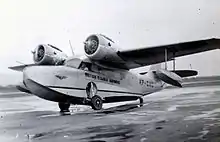
- Yaukuve Resort
- Merpati Nusantara Airlines – Leased a Goose from Indonesian Air Force.[27]
- SAATAS-East Indonesia[27]
- Mount Cook Airline
- Sea Bee Air

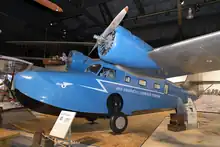
- Alaska Airlines – Alaska Airlines called their turboprop-powered aircraft the "Turbo Goose" propjet. They also operated piston-powered versions.[28]
- Alaska Coastal Airlines
- Alaska Coastal-Ellis Airlines
- Alaska Island Air
- Alaska Fish and Game
- Amphib. Inc.
- Antilles Air Boats
- Avalon Air Transport
- Catalina Air
- Catalina Channel Airlines
- Chevron of California
- Devcon Construction
- Flight Data Inc.
- Ford Motor Co.
- Gulf Oil
- Kodiak Airways
- Kodiak Western
- North Coast Aero
- Ozark Management
- Pan Air
- PenAir
- Reeve Aleutian Airways
- SouthEast Skyways
- Superior Oil
- Sun Oil Co. (Sunoco)
- Teufel Nurseries
- The Texas Company (Texaco)
- Tuthill Corporation
- Virgin Islands Seaplane Shuttle
- Webber Airlines
Accidents and incidents
- 19 November 1943
- Grumman JRF-2 of Port Heiden, Alaska (USCG), crashed with three crewmen and one passenger missing. It was found in 1987.[29]
- 13 March 1947
- A Grumman JRF-6B of Loftleiðir with seven passengers and a pilot crashed immediately after takeoff on Hvammsfjörður by the town of Búðardalur in Iceland. The pilot and four other passengers were rescued by a boat after they evacuated the plane. Three passengers could not evacuate the plane and went down with it under water. One of the passengers rescued did not survive. The pilot and three passengers survived; four passengers were killed.[30]
- 21 August 1958
- N720 crashed in the Brooks Range, near the upper Ivishak River, in Alaska, killing U.S. Fish and Wildlife Agents Clarence J. Rhode and Stanley Fredericksen, and Clarence's son Jack. The crash site was not found until August 23, 1979.[31]
- 27 January 1961
- A JRF-5 of the French Navy crashed, killing Admiral Pierre Ponchardier and five others. This accident led the French Navy to retire all of their Grumman JRF-5 Gooses in the spring of 1961.[32][33]
- 30 July 1971
- One person was killed and one was injured when a Grumman G-21A taking off from the airport in Greenville, Maine experienced engine failure or malfunction during takeoff. The NTSB determined the probable cause to be the pilot's lack of familiarity with the plane and fuel mismanagement.[34]
- 22 June 1972
- N1513V of Reeve Aleutian Airways was written off at False Pass, Alaska.[35][36]
- 2 September 1978
- Charles F. Blair Jr., former Naval Air Transport Service and Pan American Airways pilot and husband to actress Maureen O'Hara, was flying a Grumman Goose that belonged to his company, Antilles Air Boats, from St. Croix to St. Thomas in the U.S. Virgin Islands when it crashed into the ocean due to failure of the left engine. Three passengers and he were killed; seven passengers were severely injured.[37]
- 24 July 1984
- Grumman Goose G-21A, Serial # B-114, Registration: N 2021 A, Hal’s Air Service, Piloted by Hal Dierich, Four Fatalities including pilot. Collision with water in the narrow strait NW of Monashka Bay near Ouzinkie, Kodiak Island, AK. [38]
- 15 February 2005
- A 1939 Grumman Goose G-21A, registered N-327, crashed around 9:30 am in a field on Route 14A near Penn Yan, New York after an engine failure simulation went wrong. The plane fell rapidly, with the left wing hitting the ground first, before the badly damaged plane burst into flames on impact. Pilots Paul and Daryl Middlebrook, both of Penn Yan, escaped serious injury. The plane, originally owned by the Peruvian Air Force, had starred in the 1980s ABC television series Tales of the Gold Monkey as Cutter's Goose.[39][40][41]
- 3 August 2008
- A Grumman Goose of Pacific Coastal Airlines with seven passengers and crew crashed during a flight from Port Hardy to Chamiss Bay. The aircraft was completely destroyed by a fire. There were only two survivors.[42]
- 16 November 2008
- A Grumman Goose of Pacific Coastal Airlines with eight passengers and crew crashed on South Thormanby Island near Sechelt off British Columbia's Sunshine Coast in bad weather during a flight from Vancouver International Airport to Toba Inlet, BC. Only one passenger survived. The company resumed floatplane operations on November 19, 2008.[43]
- 27 February 2011
- A turbine Goose, N221AG, crashed in the United Arab Emirates when it veered immediately after takeoff.[44]
- 17 June 2014
- A Grumman G-21A Goose lost control in a snowstorm over the Montana/Idaho border and crashed into the parking lot of the Lost Trail Ski Area near the summit of Lost Trail Pass, subsequently catching fire. The plane was completely destroyed, and the pilot, who was the only occupant of the plane, was killed.[45][46]
Aircraft on display
- Canada
- B-77 – G-21A in storage at the Canada Aviation and Space Museum in Ottawa, Ontario.[47][48]
- Indonesia
- PB-521 – G-21A on static display at Suryadarma Air Force Base in Subang Regency, West Java.[49]
- Sweden
- 37810 – JRF-5 under restoration for static display at the Swedish Air Force Museum in Linköping, Östergötland.[50][51][52]
- United States
- 1048 – G-21A on static display at the Steven F. Udvar-Hazy Center of the National Air and Space Museum in Chantilly, Virginia.[53]
- 1085 – G-21A on static display at the National Naval Aviation Museum in Pensacola, Florida.[54][55]
- 1157 – G-21A under restoration for static display at the Tongass Historical Society in Ketchikan, Alaska.[56][57][58]
- B-102 - G-21A N789 on display in airworthy condition at the Alaska Aviation Museum in Anchorage, Alaska.
- B-122 – G-21A on static display at the Evergreen Aviation & Space Museum in McMinnville, Oregon.[59][60]
- B-130 – G-21A on static display at the Historic Aircraft Restoration Project in Brooklyn, New York.[61]
- Reproduction – G-21A on static display at the Cradle of Aviation Museum in Garden City, New York.[62][63][64]
Specifications (JRF-5 Goose)
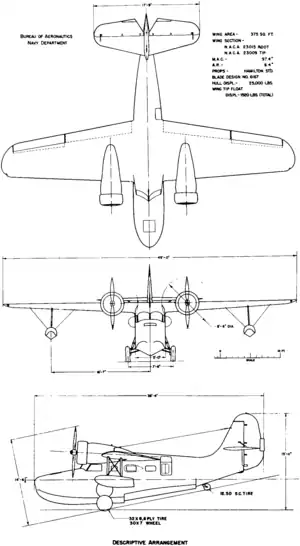
Data from United States Navy Aircraft since 1911
General characteristics
- Crew: 1-3
- Capacity: 5-7
- Length: 38 ft 6 in (11.73 m)
- Wingspan: 49 ft 0 in (14.94 m)
- Height: 16 ft 2 in (4.93 m)
- Wing area: 375 sq ft (34.8 m2)
- Airfoil: root: NACA 23015; tip: NACA 23009
- Empty weight: 5,425 lb (2,461 kg)
- Gross weight: 8,000 lb (3,629 kg)
- Powerplant: 2 × Pratt & Whitney R-985-AN-6 Wasp Junior 9-cylinder air-cooled radial piston engines, 450 hp (340 kW) each
- Propellers: 3-bladed variable-pitch propellers
Performance
- Maximum speed: 201 mph (323 km/h, 175 kn) at 5,000 ft (1,524 m)
- Cruise speed: 191 mph (307 km/h, 166 kn) at 5,000 ft (1,524 m)
- Range: 640 mi (1,030 km, 560 nmi)
- Service ceiling: 21,300 ft (6,500 m)
- Rate of climb: 1,100 ft/min (5.6 m/s)
- Wing loading: 21.3 lb/sq ft (104 kg/m2)
- Power/mass: 0.11 hp/lb (0.18 kW/kg)
Armament
- Bombs: 2 × 325 lb (147 kg) depth charges or 2 × 250 lb (110 kg) GP bombs[66]
Notable appearances in media
See also
Related development
Related lists
Notes
- "Goose." Archived 2013-01-01 at archive.today Antilles Seaplanes history page. Retrieved: August 30, 2008.
- "Grumman Goose." Archived 2011-08-05 at Wikiwix Aerofiles.com Grumman page. Retrieved: August 30, 2008.
- Truelson 1976
- "FAA Type Certificate no. 4A24". Archived 2017-01-25 at the Wayback Machine FAA. Retrieved: August 26, 2011.
- "The Grumman Goose: Replacing an Alaska aviation legend". Anchorage Daily News. 20 October 2011. Archived from the original on 12 October 2013. Retrieved 3 May 2018.
- "Seven confirmed dead in B.C. plane crash." Archived 2012-11-05 at the Wayback Machine canada.com. Retrieved: December 19, 2009.
- Francillon and Killion 1993, p.55.
- "Aircraft N642" Archived 2012-09-17 at the Wayback Machine FAA Registry. Retrieved: August 26, 2011.
- Francillon and Killion 1993, pp. 54–56.
- "FAA Registry - Aircraft - N-Number Inquiry". Archived from the original on 2014-10-11. Retrieved 2011-08-26. and "Aircraft – N70AL." Archived 2014-10-11 at the Wayback Machine FAA Registry. Retrieved: August 26, 2011.
- "Kaman K-16B Amphibious VTOL Nears Rollout". Aviation Week & Space Technology. January 11, 1960. p. 121. Archived from the original on May 23, 2016.
- "Kaman K-16B". New England Air Museum. Archived from the original on March 5, 2016. Retrieved February 26, 2016.
- Green 1968, pp. 169–170.
- Donald 1995, p. 145.
- "Hydro-Skis On Seaplanes Speed Take-Off." Popular Mechanics, January 1953, p. 119.
- Green 1968, p.169.
- March 1998, p.127.
- Núñez Padin, Jorge Felix (2009).
- http://www.adf-serials.com.au/goose.htm Brendan Cowan
- Francillon 2008, p. 37
- Hagedorn 1993, p. 68.
- "Indonesian aviation 1945-1950." Archived 14 December 2005 at the Wayback Machine adf-serials.com. Retrieved: 9 February 2021.
- Niccoli 1998, p. 39.
- Niccoli 1998, pp. 38–39.
- Thetford, 1978, p.592
- "Grumman Goose has served coast for many years as 'flying-boat workhorse'." Archived 2012-11-05 at the Wayback Machine canada.com. Retrieved: December 19, 2009.
- "South East Asia 1960s-1970s - Indonesia & Dutch New Guinea". goodall.com.au. Retrieved 9 February 2021.
- http://www.timetableimages.com Archived 2017-09-12 at the Wayback Machine, June 1, 1969 Alaska Airlines system timetable
- "US Coast Guard Aviation casualties". uscg.mil. Retrieved 3 May 2018.
- "ASN Wikibase Occurrence # 27712". Archived from the original on 10 August 2013. Retrieved 10 August 2013.
- Wilbanks, William (1999). Forgotten Heroes of Alaska. Turner Publishing Company. p. 60. ISBN 978-1-56311-511-0.
- JRF-5 Goose Archived 2015-05-04 at the Wayback Machine Retrieved: February 26, 2012.
- FNCV. "fncv federation nationale combattants volontaires france association". www.fncv.com. Retrieved 3 May 2018.
- Lowell, Jessica (30 July 2018). "Plane crashes in Greenville since 1966". Kennebec Journal. Press Herald. Retrieved 16 August 2018.
- "N1513V." Archived 2008-10-25 at the Wayback Machine NTSB. Retrieved: December 19, 2009.
- "accident." Archived 2005-03-24 at the Wayback Machine NTSB. Retrieved: December 19, 2009. Note: States 1970 as year!?
- "Antilles Air Boats, Inc., Grumman G21A, N7777V". Accident Reports. National Transportation Safety Board. 28 June 1979. Archived from the original on 24 January 2016. Retrieved 18 March 2016.
- NTSB Report Identification: ANC84FA119, The docket is stored on NTSB microfiche number 26622
- Muscato, Gina (February 16, 2005), "Brothers survive plane crash:Vintage aircraft goes down in field near Penn Yan", Finger Lakes Times, retrieved November 20, 2022
- Livadas, Greg (February 16, 2005), "Pilot lands 'Grumman Goose' in Yates after engine trouble", Democrat and Chronicle
- Hoffman, Bryce T. (February 25, 2005), "Simulation may have caused vintage airplane to crash", The Leader
- "5 dead in B.C. plane crash." TheGlobeAndMail.com. Retrieved: December 19, 2009.
- "7 dead in plane crash off B.C. coast." Archived 2012-11-03 at the Wayback Machine CBC News, 16 November 2008. Retrieved: December 19, 2009. Viewable: https://web.archive.org/web/20121103203609/http://www.cbc.ca/news/canada/british-columbia/story/2008/11/16/bc-081115-plane-crash.html
- "Plane crash kills 4 in UAE" Archived 2011-03-01 at the Wayback Machine CNN News, February 28, 2011. Retrieved: February 28, 2011.
- "Archived copy". Archived from the original on 2014-06-18. Retrieved 2014-06-18.
{{cite web}}: CS1 maint: archived copy as title (link) - Missoulian. "Pilot killed in Lost Trail crash; witnesses describe fireball". billingsgazette.com. Archived from the original on 4 May 2018. Retrieved 3 May 2018.
- "Grumman G-21A Goose II". Ingenium. Ingenium. Retrieved 6 August 2018.
- Dupas, Ron. "No. 406B. Grumman G-21A Goose (CF-MPG c/n B.77) Royal Canadian Mounted Police". 1000AircraftPhotos.com. Retrieved 7 August 2018.
- "Grumman G-21 Goose: Pesawat Intai Amfibi Ringan TNI AU, Pernah Jadi Arsenal Skadron Udara 5". indomiliter.com (in Indonesian). 6 November 2017. Retrieved 9 February 2021.
- "TP 81". Flygvapenmuseum (in Swedish). Retrieved 28 December 2021.
- Anusewicz, Tom. "N79901". Antilles Air Boats. Retrieved 28 December 2021.
- Forsgren, Jan (28 April 2017). "Grumman Goose to be restored in Sweden". Key.Aero. Retrieved 28 December 2021.
- "Grumman G-21 Goose". Smithsonian National Air and Space Museum. Smithsonian Institution. Retrieved 6 August 2018.
- "JRF Goose". National Naval Aviation Museum. Naval Aviation Museum Foundation. Retrieved 7 August 2018.
- "Airframe Dossier - Grumman G-21/JRF/OA-9/OA-13 Goose, c/n 1085, c/r N12CS". Aerial Visuals. AerialVisuals.ca. Retrieved 7 August 2018.
- "Save The Goose Project". Tongass Historical Society. Retrieved 6 August 2018.
- Dudzak, Maria (26 May 2016). "Volunteers progress on Goose restoration". KRBD. Rainbird Community Radio. Retrieved 6 August 2018.
- "FAA Registry [N88821]". Federal Aviation Administration. U.S. Department of Transportation. Retrieved 6 August 2018.
- Miller, Phil (1 May 2017), "Visitor to the Museum" (PDF), Flightplan, Evergreen Aviation and Space Museum, p. 6, retrieved 7 August 2018
- "FAA Registry [N7811]". Federal Aviation Administration. U.S. Department of Transportation.
- "Airframe Dossier - Grumman JRF-5 Goose, s/n 87736 USN, c/n B-130, c/r N644R". Aerial Visuals. AerialVisuals.ca. Retrieved 6 August 2018.
- "Grumman G-21 Goose". Cradle of Aviation Museum. Retrieved 6 August 2018.
- Haynes, Eddy. "S/N 1051". Goose Central. Retrieved 1 February 2021.
- Denton, Guy. "N327 C/N 1051". The Grumman Goose and Widgeons. Retrieved 1 February 2021.
- Green 1968, p.171.
Bibliography
- Ablitzer, Fabrice. "Round-Out". Air Enthusiast, No. 79, January/February 1999. p. 79. ISSN 0143-5450.
- Donald, David, ed. American Warplanes of World War II. London: Aerospace Publishing, 1995. ISBN 1874023727.
- Francillon, René J. and Gary L. Killion. "Sauce for the Goose – turbine style". Air International, July 1993, Vol. 45, No 1, pp. 53–57. Stamford, UK:Key Publishing. ISSN 0306-5634.
- Francillon, René J (March 2008). "Grumman G-21 "Goose": L'oie qui ne se pose jamais". Le Fana de l'Aviation (in French). No. 460. pp. 32–40.
- Green, William. War Planes of the Second World War: Volume Five Flying Boats. London:Macdonald, 1968. ISBN 0-356-01449-5.
- Hagedorn, Daniel P. (1993). Central American and Caribbean Air Forces. Tonbridge, Kent, UK: Air-Britain (Historians) Ltd. ISBN 0851302106.
- Ledet, Michel (April 2002). "Des avions alliés aux couleurs japonais" [Allied Aircraft in Japanese Colors]. Avions: Toute l'Aéronautique et son histoire (in French) (109): 17–21. ISSN 1243-8650.
- March, Daniel J., ed. British Warplanes of World War II. London: Aerospace Publishing, 1998. ISBN 1874023921.
- Niccoli, Riccardo. "Pottuguese Numerology: Serial systems used by the Aeronautica Militar and the Força Aerea Portuguesa". Air Enthusiast, May–June 1998, No. 75. pp. 33–40. ISSN 0143-5450.
- Núñez Padin, Jorge Felix (2009). Núñez Padin, Jorge Felix (ed.). JRF Goose, PBY Catalina, PBM Mariner & HU-16 Albatros. Serie Aeronaval (in Spanish). Vol. 25. Bahía Blanca, Argentina: Fuerzas Aeronavales. ISBN 978-9872055745.
- Swanborough, Gordon and Peter M. Bowers. United States Navy Aircraft since 1911. London: Putnam, Second edition, 1976. ISBN 0370100549.
- Thruelsen, Richard. The Grumman Story. New York: Praeger Publishers, Inc., 1976. ISBN 0-275-54260-2.
- Winchester, Jim, ed. "Grumman Goose/Mallard." Biplanes, Triplanes and Seaplanes (The Aviation Factfile). Rochester, Kent, UK: Grange Books plc, 2004. ISBN 1840136413.
.jpg.webp)